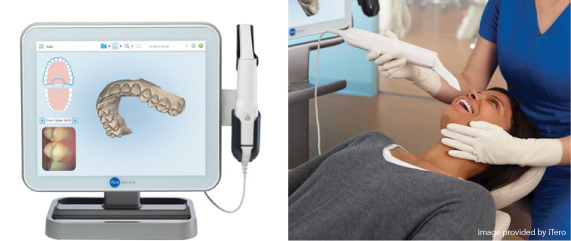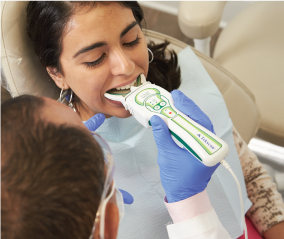Digital Occlusion Analysis vs. Intraoral Scanners
These two pieces of technology have become standards of care in dentistry. However, while both provide valuable digital information, they are definitely not the same. Let’s break down the differences between digital occlusion analysis and intraoral scanners.
Intraoral Scanners
Intraoral scanners are rapidly replacing the traditional dental impression technique. A dentist inserts a tray of putty into the patient’s mouth, the patient bites down and holds until the putty hardens, then they remove it from the patient’s mouth. This makes an impression that will be used to make a model of the patient’s teeth, usually at a laboratory. This model can be used when the dentist is designing implants, crowns, bridges, braces, or other prosthetics. It allows the dentist to work on a treatment away from the patient.
An intraoral scanner digitizes the dental impression process, doing away with trays, putty, and probably some patient gagging.

An intraoral scanner is essentially a wand that is inserted into the patient’s mouth for a few seconds that scans the mouth using one of various light beam technologies, depending on the model. These scans generate a 3D digital model of the patient’s teeth to be viewed on a computer or tablet.
A digital model allows for a digital workflow, where files can be sent to a lab to have a prosthetic designed and milled, or milled chairside by the clinician. This is a much faster and more efficient process than it used to be.
Intraoral scanners now come equipped with all sorts of functionality—one being an indication of occlusal clearance when designing restorations. Some even have virtual articulators that calculate the dimensions of the bite coming together. This feature is certainly helpful in the design process, but once the prosthetic is delivered, the need for occlusal adjustment exists. This is where digital occlusal analysis and intraoral scanners differ significantly.
An intraoral scanner can’t replicate a patient biting or performing functional movements in real time. So while an intraoral scanner can help you visualize a patient’s bite, it doesn’t provide any actionable data about the patient’s bite. That’s where digital occlusion analysis comes in.
Digital Occlusion Analysis
 When you hear about occlusion, you may first think of articulating paper. This is the analog method of identifying bite imbalances, and offers no objective data. It leaves ink on the teeth after the patient’s occlusal planes come into contact.
When you hear about occlusion, you may first think of articulating paper. This is the analog method of identifying bite imbalances, and offers no objective data. It leaves ink on the teeth after the patient’s occlusal planes come into contact.
What it doesn’t tell you is how much force was applied to create each ink spot. This creates occlusion confusion for the dentist.
A tool like T-Scan™ provides the data that articulating paper cannot. T-Scan not only shows where the teeth come together, but also the force at each of those points. T-Scan can help a dentist identify imbalances in a patient’s bite and high-pressure points that can lead to pain and damage to natural teeth, restorations, and implants.
It takes a “movie” or a scan of the bite as the teeth come in and out of contact—revealing the forces on each tooth on the dentition, measuring the balance and distribution as it goes. Because it has a timing element, you can evaluate premature contacts, working and non-working interferences, and more. It allows dentists to be more accurate and efficient at occlusal analysis.
Digital occlusion analysis tools and intraoral scanners are different but can be used in tandem. This is why Tekscan makes the T-Scan compatible with STL file formats. T-Scan occlusal data can be incorporated into a digital impression to give you an accurate digital image of the patient’s bite, complete with actual force and timing measurements. We refer to it as a Digital Impression Overlay (DIO).

The combination of these tools can launch any dentist into the new age of digital dentistry. Adding data about force and symmetry to a digital impression can enhance any dentist’s ability to diagnose and treat bite issues that can interrupt a dental practice.
Do I need a T-Scan if I already have a 3D intraoral scanner that gives me occlusion data?
Yes. The T-Scan digital occlusal analysis system and intraoral scanners give you different sets of data and work perfectly together to give you a true understanding of a patient's bite.
Digital dentistry has rapidly become the standard. Whether you are sending 3D models out to a digital lab, or printing 3D aligners, orthodontics and splints in your office, you still want to measure the patient's bite before and after treatment.
When it comes to 3D (and now 4D) digital dental solutions, they are very good for designing a great case and getting you to a closer end point. However, T-Scan is the diagnostic tool that shows occlusal dysfunction and helps you get the best results out of occlusal treatment and equilibrations.
Ultimately, you will want both types of systems.
If you are using your intraoral scanner instead of making impressions with putty, it's time to move beyond articulating paper as well. Get true digital bite force and timing data integrated into your digital workflow.
Researched backed, actionable occlusion data
Studies have shown that T-Scan is a reliable and validated method for measuring the occlusal contact area, and the 3d surface scans from intraoral scanners are not. Read the research.
Learn more about digital dentistry and occlusal analysis
Hear how Dr. James Oshetski, DDS, describes the key differences between T-Scan Digital Occlusal Analysis system and Intraoral Scanners. They both serve as important tools for a dentist - but perform very different functions.

